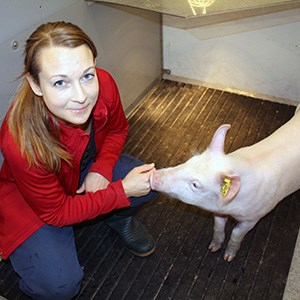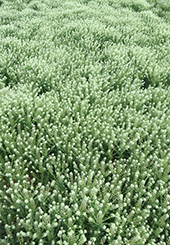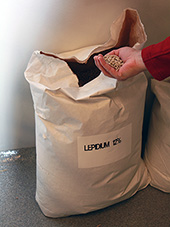Pigs seem to like eating feed that contains seedcake from the plant field cress (Lepidium campestre). For over 20 years, researchers at the Swedish University of Agricultural Sciences (SLU) in Alnarp, have been domesticating field cress into a new oil crop (and catch crop) for cultivation in especially northern Sweden.
After extracting the oil from the field cress seeds, a protein-rich seed cake remains. The researchers thought that, just as with the rapeseed cake, you should be able to use the field cress seed cake as animal feed.
But first it is important to find out if this seed cake appeal to the animals’ taste buds and how it affects their health. In a pilot study, researchers at SLU in Ultuna mixed four, eight and twelve percent seed cake from field cress into a common cereal-based feed and gave it to growing pigs. It turned out that the pigs liked their new diet. The researchers did not want to give the pigs a higher proportion of field cress than twelve percent because in its wild form the plant contains relatively high amount of unhealthy glucosinolates.
The field cress seed cake also contains relatively high levels of insoluble fiber. This, together with the glucosinolate content, was found to result in a somewhat lower digestibility (how much of the nutrition the pig actually utilize) among the pigs eating the seed cake, but otherwise the researchers did not see any negative health effects of the new feed.
Because the digestibility of the field cress feed was lower among the young growing pigs, the researchers suggests that the field cress seedcake should perhaps be given to adult sows and ruminant animals, in which the slightly reduced digestion is less important. In any case until the scientists who domesticate the crop have managed to lower the glucosinolates.
One of the breeding goals is thus to reduce the content of glucosinolates in the seeds of the new crop. To succeed in this, the researchers at Alnarp is trying to stop the transport of the glucosinolates to the seeds, that is, to inhibit or eliminate the mechanism that controls the transport of the unhealthy substances into the seeds.
More information
Do you want to know more about the experiment with the pigs? Contact researcher Emma Ivarsson, Department of Animal Nutrition and Management, emma.ivarsson@slu.se, +46 (0)18-672044.
Do you want to know more about the domestication of field cress? Contact Professor Li-Hua Zhu, Department of Plant Breeding, li-hua.zhu@slu.se, +46(0)72-2363780.
Scientific article
Arefaine, H., Rydhmer, L., Andersson, R. & Ivarsson, E. 2019. Lepidium cake as a feedstuff for pigs. Livestock Science 225:47-52
The study was funded by Mistra, the Foundation for Strategic Environmental Research, together with the Swedish University of Agricultural Sciences in the research program Mistra Biotech.



